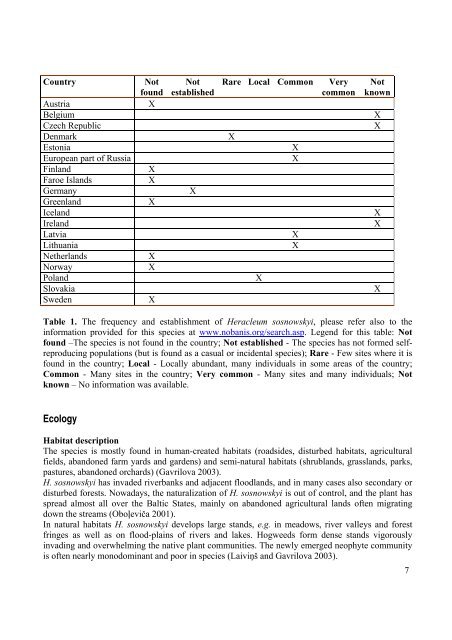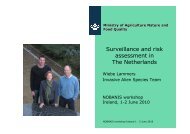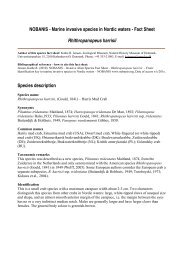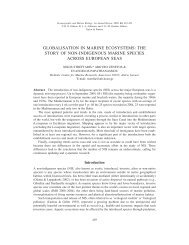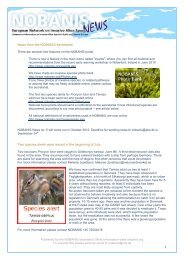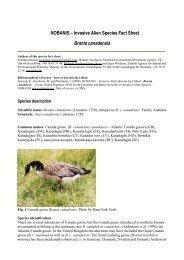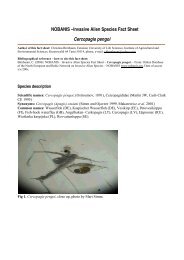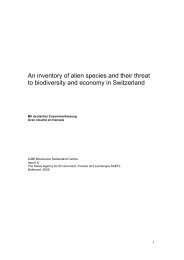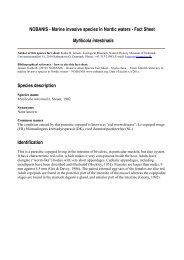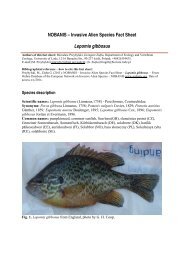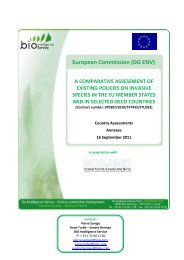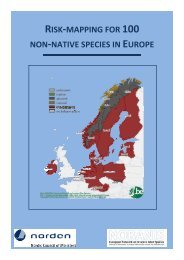NOBANIS – Invasive Alien Species Fact Sheet Heracleum sosnowskyi
NOBANIS – Invasive Alien Species Fact Sheet Heracleum sosnowskyi
NOBANIS – Invasive Alien Species Fact Sheet Heracleum sosnowskyi
Create successful ePaper yourself
Turn your PDF publications into a flip-book with our unique Google optimized e-Paper software.
Country Not Not Rare Local Common Very Not<br />
found established<br />
common known<br />
Austria X<br />
Belgium X<br />
Czech Republic X<br />
Denmark X<br />
Estonia X<br />
European part of Russia X<br />
Finland X<br />
Faroe Islands X<br />
Germany X<br />
Greenland X<br />
Iceland X<br />
Ireland X<br />
Latvia X<br />
Lithuania X<br />
Netherlands X<br />
Norway X<br />
Poland X<br />
Slovakia X<br />
Sweden X<br />
Table 1. The frequency and establishment of <strong>Heracleum</strong> <strong>sosnowskyi</strong>, please refer also to the<br />
information provided for this species at www.nobanis.org/search.asp. Legend for this table: Not<br />
found <strong>–</strong>The species is not found in the country; Not established - The species has not formed selfreproducing<br />
populations (but is found as a casual or incidental species); Rare - Few sites where it is<br />
found in the country; Local - Locally abundant, many individuals in some areas of the country;<br />
Common - Many sites in the country; Very common - Many sites and many individuals; Not<br />
known <strong>–</strong> No information was available.<br />
Ecology<br />
Habitat description<br />
The species is mostly found in human-created habitats (roadsides, disturbed habitats, agricultural<br />
fields, abandoned farm yards and gardens) and semi-natural habitats (shrublands, grasslands, parks,<br />
pastures, abandoned orchards) (Gavrilova 2003).<br />
H. <strong>sosnowskyi</strong> has invaded riverbanks and adjacent floodlands, and in many cases also secondary or<br />
disturbed forests. Nowadays, the naturalization of H. <strong>sosnowskyi</strong> is out of control, and the plant has<br />
spread almost all over the Baltic States, mainly on abandoned agricultural lands often migrating<br />
down the streams (Oboļeviča 2001).<br />
In natural habitats H. <strong>sosnowskyi</strong> develops large stands, e.g. in meadows, river valleys and forest<br />
fringes as well as on flood-plains of rivers and lakes. Hogweeds form dense stands vigorously<br />
invading and overwhelming the native plant communities. The newly emerged neophyte community<br />
is often nearly monodominant and poor in species (Laiviņš and Gavrilova 2003).<br />
7


